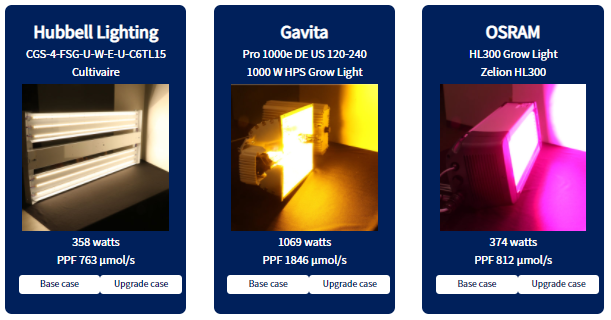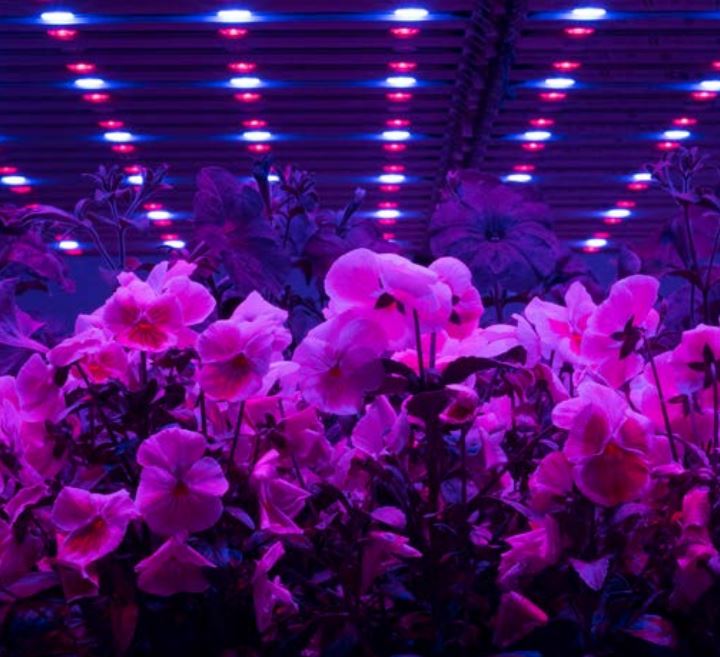Please click here to access the main AHDB website and other sectors.
- Home
- LED Lighting calculators
LED Lighting calculators
The emergence of LEDs as a viable light source has opened up new possibilities for horticulture that previous systems, based on sodium or fluorescent lamps, could not provide.
As well as their established energy saving and long-life properties, LEDs can be manufactured to produce, not only full-spectrum white light, but also particular wavelengths. From far red to UV, they make it possible to irradiate particular plants, or growth stages, with only the spectra to which they respond. Also, LEDs may be suspended amongst the plants in continuous luminaires designed for interlighting, to supplement toplighting.
This proliferation of options has driven the need for specification tools, and GrowSave has taken a look at those currently on offer. Here, we aim to explain their features and to point users to a suitable one, as it is important to realise that different tools are aimed at different users.
Manufacturers of LED chips and modules (such as Lumileds, Cree and Samsung) provide tools to assist manufacturers with luminaire design. Our interest, however, is in tools that illustrate the effect provided by horticultural lighting installations, by calculating the LED fixture layout needed to provide the required photon flux density.
A number of products are available and we take a look at them below.
Tools evaluated
Horticulture Luminaire Calculator
This powerful free tool, aimed at the end user, is based on a framework (Lighting Research Center, Rensselaer Polytechnic Institute, 2018) for evaluating horticultural luminaires.
The tool compares how different commercially available luminaires achieve equal Photosynthetic Photon Flux Density (PPFD – the horticultural equivalent of architectural illuminance), through the analysis of luminaire and application metrics, using IES photometric data and spectral power distribution. It calculates what quantity to mount at what height, capital and operational costs, and the payback period for upgrade of an existing installation (if there is one).
By creating a user account, users can add their preferred luminaires (including photometric and other data), or use the luminaires contained in the tool’s database, which are mainly from the US market:
- LED products from GE Lighting, Sunlight Supply, LumiGrow, P.L. Light Systems, Illumitex, Heliospectra, Philips Lighting and Osram
- HPS products from Gavita and P.L. Light Systems
- Metal Halide products from P.L. Light Systems
T5 Fluorescent products from Hubbell Lighting

Fig 1. Selecting a luminaire
Having selected luminaires for the Base Case and Upgrade, the user then defines the application parameters, which include mounting height (in feet and inches – as it’s American), Daily Light Integral (the product of PPFD and daily operating hours), and economics (energy cost, inflation and system lifetime). Economic data is entered including luminaire purchase, installation, cleaning and servicing costs (in £, € or $, if consistent throughout), and maintenance frequency.
It takes a short while to run the calculations, after which results are loaded to the user’s account. These include a luminaires comparison on flux and efficiency, a table of Luminaire System Application Efficacy at a range of mounting heights, lifecycle cost analysis and year-on-year costs.
LRC’s framework studies in 2018, found that:
- Compared to HPS, around three times as many LED luminaires are needed to provide similar PPFD
- Intensity distribution is important: two LED luminaires tested had higher efficacy than HPS types, but the greenhouse application still drew more power
- Due to their size and the fact that more are needed, LED luminaires increase shading, and reduce daylight by 13-55% compared with 5% from HPS luminaires
However, it is important to note that as technology improves, this situation may change.
Find out more about the Horticulture Luminaire Calculator
Osram Horticulture Tool
Any manufacturer naturally focuses on its own products. Many offer calculators for integrating LEDs into luminaires, but Osram’s also allows the designer to apply the result to a user-defined greenhouse layout. Its calculations are based on the light distribution of the LEDs themselves, any optical characteristics of the luminaire being unknown.
Find out more about the Osram Horticulture Tool
Hortinergy
This French simulation tool evaluates heat demand, solar radiation and running cost of a specified greenhouse project. The user inputs all greenhouse design information including:
- Position
- Dimensions
- Crop
- Climate and control
- Heating
- Lighting: type (SON or LED), power and efficiency, and control
Distribution, uniformity, spacing etc. are not included. After a short processing delay, the tool returns full reports detailing the resulting climate and energy consumption. Greenhouse Gas emissions are optional.
The tool is intended for consultants, and a free trial is offered.
Find out more about Hortinergy
Conclusion
We consider the most appropriate tool, to be the Horticulture Luminaire Calculator. This gives the general impression that in an upgrade scenario, there is often no realistic payback because (compared to HPS) more LED units are needed, and energy savings are low.
However, for newbuild, where the cost of LED is compared with that of HPS, the calculator can help to select a luminaire, comparing two options’ installation and operating costs and light output. The research behind it allows growers to choose the most appropriate lights for them, and then to calculate the layout for their desired lighting strategy.


